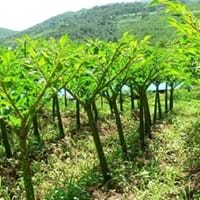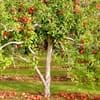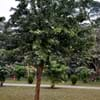Life Span
Perennial
Perennial
Type
Flowering Plants, Fruits, Trees
Bulb or Corm or Tuber
Origin
Central Asia
Southeastern Asia
Types
Aceymac apple, Bailey Sweet apple, Dabinett apple, Nehou apple
Amorphophallus yunnanensis , Amorphophallus titanum
Habitat
Hillside
Loamy soils, Well Drained
USDA Hardiness Zone
5-8
6-11
Sunset Zone
A1, A2, A3, 8, 9, 10, 11, 12, 13, 14, 15, 16, 17, 18, 19, 20, 21, 22, 23, 24
21,22
Habit
Oval or Rounded
Upright/Erect
Flower Color
White
Purple, Burgundy
Flower Color Modifier
Not Available
Bicolor
Fruit Color
Green, Red
Not Available
Leaf Color in Spring
Dark Green
Not Available
Leaf Color in Summer
Green
Light Green
Leaf Color in Fall
Brown, Green, Light Yellow
Several shades of Green
Leaf Color in Winter
Not Available
Light Green
Leaf Shape
Oblong
Pinnate
Plant Season
Spring
Spring, Summer, Fall
Sunlight
Full Sun, Partial shade
Partial Sun, Partial shade
The pH of Soil
Neutral
Acidic, Neutral
Soil Drainage
Well drained
Well drained
Bloom Time
Fall, Summer
Spring, Late Spring
Tolerances
Drought
Drought
Where to Plant?
Ground
Ground
How to Plant?
Grafting, Seedlings, Transplanting
Seedlings, Transplanting, Vegetative Reproduction
Plant Maintenance
Medium
Medium
Watering Requirements
Medium
Allow to dry out slightly between watering, Do Not over Water
In Summer
Lots of watering
Lots of watering
In Spring
Moderate
Moderate
In Winter
Average Water
Average Water
Soil pH
Neutral
Acidic, Neutral
Soil Drainage Capacity
Well drained
Well drained
Sun Exposure
Full Sun, Partial shade
Partial Sun, Partial shade
Pruning
Prune when plant is dormant, Remove dead or diseased plant parts
Generally pruned to waist height, Remove damaged leaves, Remove dead branches, Remove dead leaves
Fertilizers
All-Purpose Liquid Fertilizer
fertilize in growing season, organic fertlizers
Pests and Diseases
Aphids, Canker, Caterpillars, Powdery mildew, Root rot
Nematodes, Root mealy bugs
Plant Tolerance
Drought
Dry soil, Full Sun, Shade areas
Flower Petal Number
Single
Single
Foliage Texture
Medium
Bold
Foliage Sheen
Matte
Matte
Attracts
Birds
Aphids, Bugs, Butterflies
Allergy
Mouth itching, Throat itching
gastro-intestinal problems, Swelling in mouth
Aesthetic Uses
Not Available
Not Available
Beauty Benefits
Not Available
Glowing Skin, Maintains teeth healthy, Weightloss
Environmental Uses
Air purification
Food for animals, Food for birds, Very little waste
Medicinal Uses
Cancer, constipation, Diabetes, Diarrhea, Dysentry, Fever, Heart problems, Tooth ache
Asthma, Burns, Cough, Diabetes
Part of Plant Used
Fruits
Bulbs, Leaves
Other Uses
Used As Food, Wood is used for making furniture
Animal Feed, Can be made into a herbal tea, Cosmetics
Used As Indoor Plant
No
No
Used As Outdoor Plant
Yes
Yes
Garden Design
Fruit / Fruit Tree, Shade Trees, Showy Tree
Container, Edible, Feature Plant, Houseplant, Mixed Border, Tropical
Botanical Name
Malus domestica
AMORPHOPHALLUS konjac
Common Name
Apple Tree
Devil's Tongue, Elephant Yam, Konjac
In Hindi
सेब का वृक्ष
Konjac
In German
Apfelbaum
Teufelszunge
In Spanish
Manzano
konjac
In Portuguese
Macieira
konjac
Phylum
Magnoliophyta
Magnoliophyta
Class
Magnoliopsida
Liliopsida
Genus
Malus
Amorphophallus
Clade
Angiosperms, Eudicots, Rosids
Angiosperms, Monocots
Tribe
Not Available
Thomsonieae
Subfamily
Not Available
Aroideae
Number of Species
Not Available
Not Available
Importance of Apple Tree and Konjac
Want to have the most appropriate plant for your garden? You might want to know the importance of Apple Tree and Konjac. Basically, these two plants vary in many aspects. Compare Apple Tree and Konjac as they differ in many characteristics such as their life, care, benefits, facts, etc. Every gardener must at least have the slightest clue about the plants he wants to plant in his garden. Compare their benefits, which differ in many ways like facts and uses. The medicinal use of Apple Tree is Cancer, constipation, Diabetes, Diarrhea, Dysentry, Fever, Heart problems and Tooth ache whereas of Konjac is Asthma, Burns, Cough and Diabetes. Apple Tree has beauty benefits as follows: Not Available while Konjac has beauty benefits as follows: Not Available.
Compare Facts of Apple Tree vs Konjac
How to choose the best garden plant for your garden depending upon its facts? Here garden plant comparison will help you to solve this query. Compare the facts of Apple Tree vs Konjac and know which one to choose. As garden plants have benefits and other uses, allergy is also a major drawback of plants for some people. Allergic reactions of Apple Tree are Mouth itching and Throat itching whereas of Konjac have gastro-intestinal problems and Swelling in mouth respectively. Having a fruit bearing plant in your garden can be a plus point of your garden. Apple Tree has showy fruits and Konjac has no showy fruits. Also Apple Tree is flowering and Konjac is not flowering . You can compare Apple Tree and Konjac facts and facts of other plants too.





